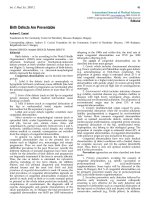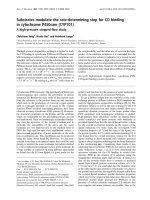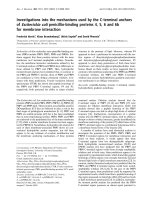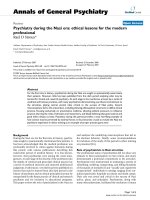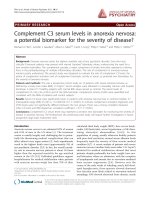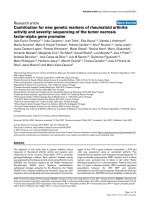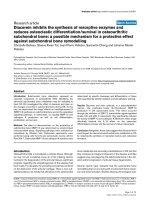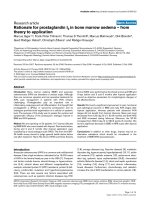Báo cáo y học: "Protocol for the Foot in Juvenile Idiopathic Arthritis trial (FiJIA): a randomised controlled trial of an integrated foot care programme for foot problems in JIA" pdf
Bạn đang xem bản rút gọn của tài liệu. Xem và tải ngay bản đầy đủ của tài liệu tại đây (291.85 KB, 10 trang )
BioMed Central
Page 1 of 10
(page number not for citation purposes)
Journal of Foot and Ankle Research
Open Access
Study protocol
Protocol for the Foot in Juvenile Idiopathic Arthritis trial (FiJIA): a
randomised controlled trial of an integrated foot care programme
for foot problems in JIA
Gordon J Hendry*
1
, Deborah E Turner
1
, John McColl
2
, Paula K Lorgelly
3
,
Roger D Sturrock
4
, Gordon F Watt
1
, Michael Browne
5
, Janet Gardner-
Medwin
5
, Lorraine Friel
6
and Jim Woodburn
1
Address:
1
School of Health and Social Care, Glasgow Caledonian University, Cowcaddens Road, Glasgow, UK,
2
Department of Statistics,
University of Glasgow, University Avenue, Glasgow, UK,
3
Division of Community Based Sciences, University of Glasgow, University Avenue,
Glasgow, UK,
4
Centre for Rheumatic Diseases, University of Glasgow, University Avenue, Glasgow, UK,
5
Department of Child Health, University
of Glasgow, University Avenue, Glasgow, UK and
6
NHS Greater Glasgow and Clyde, Glasgow Royal Infirmary, 16 Alexandra Parade, Glasgow, UK
Email: Gordon J Hendry* - ; Deborah E Turner - ; John McColl - ;
Paula K Lorgelly - ; Roger D Sturrock - ; Gordon F Watt - ;
Michael Browne - ; Janet Gardner-Medwin - ;
Lorraine Friel - ; Jim Woodburn -
* Corresponding author
Abstract
Background: Foot and ankle problems are a common but relatively neglected manifestation of
juvenile idiopathic arthritis. Studies of medical and non-medical interventions have shown that
clinical outcome measures can be improved. However existing data has been drawn from small
non-randomised clinical studies of single interventions that appear to under-represent the adult
population suffering from juvenile idiopathic arthritis. To date, no evidence of combined therapies
or integrated care for juvenile idiopathic arthritis patients with foot and ankle problems exists.
Methods/design: An exploratory phase II non-pharmacological randomised controlled trial
where patients including young children, adolescents and adults with juvenile idiopathic arthritis and
associated foot/ankle problems will be randomised to receive integrated podiatric care via a new
foot care programme, or to receive standard podiatry care. Sixty patients (30 in each arm) including
children, adolescents and adults diagnosed with juvenile idiopathic arthritis who satisfy the inclusion
and exclusion criteria will be recruited from 2 outpatient centres of paediatric and adult
rheumatology respectively. Participants will be randomised by process of minimisation using the
Minim software package. The primary outcome measure is the foot related impairment measured
by the Juvenile Arthritis Disability Index questionnaire's impairment domain at 6 and 12 months,
with secondary outcomes including disease activity score, foot deformity score, active/limited foot
joint counts, spatio-temporal and plantar-pressure gait parameters, health related quality of life and
semi-quantitative ultrasonography score for inflammatory foot lesions. The new foot care
programme will comprise rapid assessment and investigation, targeted treatment, with detailed
outcome assessment and follow-up at minimum intervals of 3 months. Data will be collected at
baseline, 6 months and 12 months from baseline. Intention to treat data analysis will be conducted.
Published: 30 June 2009
Journal of Foot and Ankle Research 2009, 2:21 doi:10.1186/1757-1146-2-21
Received: 20 February 2009
Accepted: 30 June 2009
This article is available from: />© 2009 Hendry et al; licensee BioMed Central Ltd.
This is an Open Access article distributed under the terms of the Creative Commons Attribution License ( />),
which permits unrestricted use, distribution, and reproduction in any medium, provided the original work is properly cited.
Journal of Foot and Ankle Research 2009, 2:21 />Page 2 of 10
(page number not for citation purposes)
A full health economic evaluation will be conducted alongside the trial and will evaluate the cost
effectiveness of the intervention. This will consider the cost per improvement in Juvenile Arthritis
Disability Index, and cost per quality adjusted life year gained. In addition, a discrete choice
experiment will elicit willingness to pay values and a cost benefit analysis will also be undertaken.
Trial Registration: Trial registration number: UKCRN5045
Background
Juvenile Idiopathic Arthritis (JIA) is the commonest rheu-
matic disease in childhood with a variable worldwide
prevalence ranging from 0.07 to 4.01 per 1000 children
[1], while in the UK the prevalence is estimated at between
0.65 and 2.0 per 1000 children [1-3]. Foot problems have
been reported as being common in JIA with 90% of chil-
dren in a cross-sectional survey presenting with at least
one foot problem associated with the disease process [4].
Foot and related problems attributable to JIA include syn-
ovitis, deformity, pain, stiffness, limited joint range of
motion, enthesitis, and bony erosions [4-8]. As such,
many sufferers have a reduced capacity to function [9]
poorer health related quality of life (HRQOL) [10,11],
and high health care costs have been reported [12,13].
Significant advances in the pharmacological management
of JIA have taken place with the advocated earlier use of
intra-articular cortico-steroid injections (ICIs), disease
modifying anti-rheumatic drugs (DMARDs) and biologic
therapies. These drugs have greatly improved the treat-
ment options for paediatric rheumatologists, and func-
tional outcomes appear to have improved as a result
[14,15]. This shift towards earlier and more aggressive
medical management has not been accompanied by spe-
cific foot related research. Further investigation is required
to determine the prevalence and severity of foot problems
in JIA, and also to evaluate the effectiveness of the current
available treatments for such problems in the short and
long term.
Our recent survey of foot problems and medical and podi-
atric management in a small 30 patient cohort with JIA
found that patients with JIA can experience mild to mod-
erate foot related impairments and disability despite med-
ical management in line with modern day treatment
paradigms [16]. Podiatry care included provision of cus-
tomised functional foot orthoses, intrinsic muscle stretch-
ing and strengthening exercises, footwear advice and
silicone digital splinting appliances. These podiatric treat-
ment methods appeared to be in line with current recom-
mendations [17]. However there are no recognised
podiatry clinical practice guidelines for foot care in JIA
and supporting evidence of efficacy is lacking. Foot
orthoses have been evaluated in one small prospective
study indicating short-term (3 month) reduction in pain
and improved function and quality life with greater bene-
fits from custom versus prefabricated devices or athletic
shoes alone [18]. The study is limited in that the sample
did not include adults with JIA, and only patients with
foot or ankle involvement for a period of 2 years or less
were recruited. This reduces the ability to generalise the
results of the study to a wider population of patients with
JIA who have foot involvement, and this is acknowledged
by the authors in the discussion of study limitations [18].
Foot problems are often neglected as patients often reach
podiatry too late for effective intervention, possibly due to
technical difficulty or lack of recognition [19]. Our recent
retrospective analysis of patient case-notes showed that
only 18 of over 250 patients with JIA at one paediatric
rheumatology centre were referred for podiatric opinion
over a one year period [16]. However the authors
acknowledge that some patients may have been referred
to the orthotics service. To date there have been no other
reports of the frequency of referral of patients with JIA
from paediatric rheumatology to podiatry services. It
appears probable that there is an unmet need for foot care
within this population. Problems with delay in access to
appropriate care in JIA are well recognised. There is a sug-
gestion that there is a small therapeutic window of oppor-
tunity which if missed results in prolonged untreated
active disease and poor long-term outcome [20].
Treatment for foot and ankle disease in JIA has focused on
the use of intra-articular cortico-steroid injections (ICIs),
physiotherapy, orthoses and orthopaedic surgery as an
adjunct to medical care to both resolve synovitis and to
correct or maintain foot posture and function. By adding
podiatry to usual medical care, thus relying on largely pal-
liative mechanical based treatments, it appears unlikely
that a significant improvement in foot health is attaina-
ble. In order to provide optimum foot care, it is essential
that disease activity and early joint destruction be moni-
tored [21]. Use of a sensitive imaging technique can be
adopted in patients with early arthritis to obtain accurate
identification of the anatomical damage caused by
inflammatory processes [22]. The current gold-standard
in diagnostic imaging is magnetic resonance imaging
(MRI). In comparison ultrasonography (US) is an inex-
pensive, readily accessible and valuable diagnostic imag-
ing technique which can demonstrate both inflammatory
and destructive changes [23-25] and improve the efficacy
of ICIs [25,26].
Journal of Foot and Ankle Research 2009, 2:21 />Page 3 of 10
(page number not for citation purposes)
In a clinical setting podiatric assessment of patients with
JIA includes visual observation of gait, obtaining a
detailed patient history, and physical examination. How-
ever simple visual observation of gait seems insufficient
for identifying often subtle deviations from 'normal' gait
patterns. Fairburn et al [27] demonstrated that instru-
mented gait analysis has a valuable role in JIA to provide
a clear description between primary gait abnormalities
and secondary compensations and to allow optimal tar-
geting of physiotherapy and orthotic interventions. There-
fore, by employing ultrasonography and instrumented
gait analysis, both specific lesions (synovitis/tenosynovi-
tis/enthesitis/erosions) and functional deficits (antalgia/
asymmetry) may be detected and targeted with appropri-
ate interventions such as ICIs, customised orthoses and
physical therapies.
Medical treatments in JIA appear to be well driven by out-
come as preliminary definitions for improvement, mini-
mal disease activity, inactive disease and clinical
remission have been developed using the core outcome
variables. These provide physicians with realistic thera-
peutic objectives [28-30]. Without objective and specific
measures of foot related impairments and disability it is
unlikely that clinical improvements can be detected. Cur-
rently there are no such outcome measures used in the
routine podiatric care of children with JIA despite the
recent development and validation of a disease and foot
specific outcome measure; the JAFI [31]. The administra-
tion of a simple clinical measure such as the JAFI ques-
tionnaire as an appendage to routine medical note taking
could permit objective monitoring of patients over time.
Furthermore, clinicians can use clinical outcome meas-
ures to set realistic therapeutic goals in order to gauge
improvements in their patients' conditions following
interventions.
To summarise, there is a paucity of evidence to support
simple podiatry alone as a complex intervention for foot
problems in JIA patients. However significant improve-
ments in the delivery of overall foot care may lead to a
substantial increase in the uptake of this service. Utilisa-
tion of standardised and validated outcomes, as well as
employing imaging techniques and thorough gait analysis
should allow accurate monitoring, evaluation and appro-
priate alteration of treatments to achieve maximum treat-
ment efficacy.
The FiJIA (Foot in Juvenile Idiopathic Arthritis) group aim
to conduct an exploratory non-pharmacological phase II
[32] randomised controlled trial of a new podiatry led
integrated foot care programme versus current standard
care podiatry for JIA patients with foot problems. The pri-
mary aim of this study is to evaluate the clinical and cost
effectiveness of standard care podiatry and a new inte-
grated foot care programme in the management of foot
problems in JIA patients. The secondary aim of the study
will be to determine what the optimum timing for inter-
vention is in these patients by comparing the outcomes of
pre-determined groups at different stages of the disease
(children, adolescents and adults).
Methods/design
Study design and setting
FiJIA is a secondary-care based pragmatic exploratory ran-
domised controlled trial where children (under 10 years
of age) adolescents (between 10 and 16 years of age) and
adults (16 years of age and over) will receive either stand-
ard care podiatry or intervention via a new foot care pro-
gramme. A summary design is given in figure 1. A full
economic evaluation will also be conducted.
Ethical considerations
Full ethical approval for this study has been obtained
(REC ref. 08/S0709/36). The trial steering committee will
monitor the progress of the study at 6 month intervals.
Identification of eligible patients
Children aged 16 and under will be recruited from the
outpatient paediatric rheumatology clinic at The Royal
Hospital for Sick Children, Yorkhill, Glasgow. Adults
whose arthritis started in childhood will be recruited from
the Centre for Rheumatic Diseases at Glasgow Royal Infir-
mary. Patients with JIA will be identified from existing
clinical lists. At their routine clinical appointment, poten-
tial participants will be introduced to the study by their
consultant and, if interested, the patients are to be intro-
duced to the research team for more information. Patients
will be screened for suitability according to the inclusion/
exclusion criteria (see below). A minimum period of 24
hours will be provided before contacting potential partic-
ipants by telephone to confirm willingness to participate
in the trial and an appointment made for baseline visit.
Inclusion/exclusion criteria
All participants must have JIA diagnosed by their consult-
ant rheumatologist, according to the ILAR 2004 criteria. In
addition, participants are to be included if they satisfy one
of the following:
(i) Documented arthritis in the foot including small
joints
(ii) Lower limb arthritis of two or more large joints
(hips, knees, ankles and subtalar joints).
(iii) Widespread polyarthritis involving large and
small joints.
Journal of Foot and Ankle Research 2009, 2:21 />Page 4 of 10
(page number not for citation purposes)
Patients with only upper limb, jaw, or neck involvement
only will be excluded, along with those unable to cooper-
ate with the study. Participants may also be excluded from
the study (prior to randomisation) on the basis that: -
(i) Any lesion detected during the ultrasound foot scan
is not typical of synovitis (for example tumour, septic
arthritis)
(ii) The lesion may require biopsy
(iii) The lesion requires referral for a second opinion
Randomisation
Treatment allocation will be conducted by means of min-
imisation, a highly effective method of allocation which
has been recommended for use in randomised controlled
trials [33]. Using this method, treatment allocated to the
next trial participant depends on the characteristics of
those participants already enrolled, with the ultimate aim
of 'minimising' the imbalance between groups [34]. Min-
imisation in this case will be adopted to achieve balance
between groups using the following characteristics:
(i) Age
(ii) Gender
(iii) JAFI-IMP score
This method will be conducted by the same researcher
(GH) using the minimisation software package Minim
[35].
Blinding
At baseline all assessors are blinded to the outcome of
allocation. The standard care arm podiatrist will be
blinded to participants' inclusion in the usual care arm of
the trial to ensure that normal clinical practice remains so.
The researcher conducting minimisation (GH) will be
blinded to the results of all assessments and outcome
measures except the JAFI-IMP score which is required to
allocate participants through minimisation. The complex
design of the trial necessitates that patients are aware of
the outcome of allocation to either trial arm. However, in
an attempt to reduce the placebo effect all patients will be
informed that it is not known whether one intervention is
more effective than the other. The primary outcome meas-
ure (JAFI) will be administered by one assessor (MB) who
will remain blinded to the outcome of allocation at each
time point.
Initial assessments and outcome measures
At baseline all participants will be assessed to ensure they
satisfy the inclusion criteria. Demographic and disease
characteristic data such as age, gender, height, weight, dis-
Summary diagram of JIA Foot Care Programme trial designFigure 1
Summary diagram of JIA Foot Care Programme trial design.
Patients identified from Paediatric
Rheumatolo
gy
Outpatient Clinics
Patients registered for trial
Exclusions
Registered but
not
randomised
Randomisation
Usual Care
New JIA Foot Care
Programme
Outcome data:
6 months
12 months
Outcome data:
6 months
12 months
Numbers:
-receiving care
-withdrawing
-lost to follow-up
Numbers:
-receiving care
-withdrawing
-lost to follow-up
Journal of Foot and Ankle Research 2009, 2:21 />Page 5 of 10
(page number not for citation purposes)
ease sub-type, date of diagnosis, disease duration will also
be recorded. All baseline assessments, primary and sec-
ondary outcome measures will be recorded prior to allo-
cation to either the usual care arm or the intervention arm.
The medical and physiotherapy care plans will be com-
mitted to paper prior to randomisation.
The primary outcome is the Juvenile Arthritis Foot Disa-
bility Index (JAFI) [31]. This questionnaire is organised by
three dimensions related to impairment (9 items), activity
limitation (14 items) and participation restriction (4
items) with a 5-point Likert scale for each item. Each point
on the 5-point likert scale represents the frequency of the
foot problem stated for that particular item during the
past week (0 = Never, 1 = Occasionally/Less than once a
week, 2 = Sometimes/Once a week, 3 = Frequently/Two to
three times a week, and 4 = Always). Median scores are
computed for each dimension. The JAFI is completed by
parents of children <10 years and self-completed by ado-
lescent children = 10 years of age. It has been shown to be
to be valid and reliable for assessing foot-related impair-
ment and disability among children/adolescents with JIA
[31]. The JAFI has not yet been formally validated for use
in adult patients with JIA. This questionnaire will be
administered at baseline, then 6 (by post) and 12 months
from baseline. The exploratory nature of the trial will per-
mit in-depth examination of the suitability of the JAFI as
a primary outcome measure for use in definitive multi-
centre trials.
Diagnostic US will be undertaken using established meth-
odologies for the foot and ankle employing B-mode and
colour and Power Doppler [36-38]. Accessible aspects of
first through fifth metatarsophalangeal (MTP) joints will
be scanned to include the dorsal and medial 1
st
MTP joint;
dorsal and plantar 2
nd
-4
th
MTP joints and the dorsal, lat-
eral and plantar aspect of the 5
th
MTP joint [37]. Proxi-
mally, the tibio-talar, subtalar, talonavicular,
calcaneocuboid, cuneonavicular, and tarsometatarsal
joints will be scanned in both longitudinal and transverse
planes, along with the calcaneal and retrocalcaneal bursa,
the plantar fascial calcaneal enthesis, the peroneal ten-
dons, tibialis anterior, the Achilles tendon, tibialis poste-
rior, flexor hallucis longus and flexor digitorum longus
[36,38]. The semi quantitative grading system (see table
1) by Szkudlarek et al [37] will be modified used and used
to score the presence or absence of US detected pathology.
Changes in US derived pathology will be recorded
between baseline and 12 months. These scores will be site
and tissue specific (joint, tendon, bursa) rather than sum-
mated to capture response to localised treatment, for
example, tibialis posterior synovitis.
To objectively measure lower limb and foot function, spa-
tiotemporal gait parameters (walking speed, double-sup-
port time and symmetry index) will be assessed using an
instrumented walkway (GaitRITE, CIR systems, Clifton,
NJ, USA). Plantar pressure and force distribution will be
measured using a pressure platform (Emed NT, Novel
GmbH, Munich, Germany) using standardised protocols
as previously developed in adult rheumatoid arthritis and
JIA research [27,39,40]. From the gait analysis, six key var-
iables will be selected: peak pressure in the forefoot; con-
tact area in the toes; contact area in the midfoot; transfer
of centre of pressure through the foot, and the peak
ground reaction force during the loading response and
terminal stance phases. Walking speed (m/s), stride
length (m), cadences (steps/min), cycle time (% gait
cycle), and double support time will be selected as a core
set of spatiotemporal gait parameters and compared
against age/gender normative values [27,39].
Arthritis activity measures will be assessed using the Core
Outcome Variables for JIA, a validated clinical assessment
for disease activity which correlates with adult measures.
JIA patients under 16 years will have the Core Outcome
Variables recorded (consisting of the CHAQ question-
naire completed by the patient or parent, active and lim-
ited joints, and physician global assessment completed by
the doctor in clinic). For adults with JIA these will be the
physician global assessment, pain assessment, number of
tender, swollen and deformed joints and duration of early
morning stiffness and HAQ. These adult and paediatric
measures are comparable. The Glasgow Enthesitis Score, a
non-validated measure of enthesitis severity, will be
recorded by the examining doctor in all patients.
A variety of secondary outcomes will be recorded at base-
line and at the final study visit (12 months from baseline).
The Childhood Health Assessment Questionnaire
(CHAQ) and the Health Assessment Questionnaire
(HAQ) will be used as measures of overall function/disa-
bility in children/adolescents and adults respectively
[41,42], while the EQ5D will be employed to measure
general HRQoL, and will be used specifically within the
economic evaluation [43].
Patients will undergo an examination of their foot and
ankle joints to assess for active synovitis or limited joint
ranges of motion. The presence or absence of these clinical
features will be summated to derive active and limited
foot joint counts ranging 0–28. Foot deformity will be
assessed using the Structural Index (SI) to provide sum-
mated scores for rearfoot/ankle deformity (0–14) and
forefoot deformity (0–24) [44]. The SI is a validated semi-
quantitative scoring mechanism for adult subjects with
Rheumatoid Arthritis [44]. It has good face validity for use
in subjects with JIA [16] but it has not yet been formally
validated for use within this patient group.
Journal of Foot and Ankle Research 2009, 2:21 />Page 6 of 10
(page number not for citation purposes)
Interventions
Usual care
Participants randomised to usual care (standard podiatry)
will receive normal outpatient medical care. Those in cur-
rent receipt of foot care via (either adult or paediatric)
podiatry services will continue to receive care, while new
referrals will also be permitted. Referrals will be moni-
tored to ensure that medical staff referral patterns do not
change once the study has started.
Intervention
Following US identification of the anatomical structures
involved by inflammatory lesions, and altered foot and
lower limb function by instrumented gait analysis, a plan
of appropriate clinical action will be taken by the (paedi-
atric and adult) rheumatologists (JGM/RS), the podiatrists
(JW, DET & GH) and physiotherapist (LF) (summary
design is given in figure 2). If intra-articular joint injec-
tions are to be prescribed by the rheumatologists (JGM/
RS), then these will be conducted using ultrasound guid-
ance within 1 month of initial consultation. The care
plans will be agreed through discussion between the
multi-disciplinary team based on their interpretation of
the initial assessments. Participants will receive individu-
alised care packages comprising combinations of foot
orthoses and footwear treatments, physical therapies
including stretching and muscle strengthening and stand-
ard podiatry care for problems such as skin callus and in-
Table 1: Semi-quantitative ultrasound scoring system
Pathological feature Definition Scoring
Joint Effusions Defined as a compressible anechoic intra-capsular
area
0- no effusion
1- minimal amount of effusion
2- moderate amount of effusion without distension of the capsule
3- Extensive amount of effusion with distension of the joint capsule
Synovitis Defined as a non-compressible hypoechoic intra-
capsular area (synovial thickening)
0- no synovial thickening
1- minimal synovial thickening
(filling the angle between adjacent bones without bulging over the
line linking the tops of the bones)
2- synovial thickening bulging over the line of the tops of the peri-
articular bones but without extension along the bones diaphysis
3- Synovial thickening bulging over the lines linking the tops of the
peri-articular bones and with extension to at least one diaphysis
Bone erosions Changes in the bone surface of the area adjacent to
the joint
0- Regular bone surface
1- Irregularity of the bone surface without formation of a defect in
the surface of the bone seen in 2 planes
2- Defect in the surface of the bone seen in 2 planes
3- Bone defect creating extensive bone destruction
Power Doppler Display of signal flow in the synovium 0- No flow
1- Single vessel signals
2- Confluent vessel signals in less that half of the synovium
3- Vessel signals in more than half of the area
Journal of Foot and Ankle Research 2009, 2:21 />Page 7 of 10
(page number not for citation purposes)
growing toenail; these will be delivered on the same day
where possible. Customised orthoses will be manufac-
tured via an external laboratory (Firefly Orthoses, Sligo,
Ireland) according to the standardised order form, and
will be ready for fitting within two weeks. As part of the
new programme, rapid podiatry access will also be pro-
vided for unscheduled care episodes such as skin and soft-
tissue foot infections, predominantly in-growing toenail,
associated with disease modifying therapies. Finally, fur-
ther multidisciplinary care will be used to include ortho-
tist services when non-standard ankle/foot orthoses are
indicated. Clinicians will use a core set of outcomes (JAFI,
disease activity score, gait parameters and US) to chart
progress and to modify individual treatment programmes
during the trial period.
Patient follow up procedures
All participants regardless of allocation will undergo
another full assessment once they have proceeded to the
end of the trial (12 months from baseline). In the interim
period, the primary outcome questionnaire (JAFI) will be
posted at 6 months from baseline with a stamped-
addressed envelope in order to complete and return to the
study personnel. Non-responders will be sent a second
questionnaire within 2 weeks, followed by a third a fur-
ther two weeks later, and then contacted by written letter/
telephone. Participants in the intervention arm will
receive return appointments every 3 months. Any addi-
tional appointments within the intervention arm will be
made within the scope of normal clinical practice.
Economic evaluation
An economic evaluation aims to assess whether an inter-
vention provides value-for-money relative to its compara-
tor. There are three approaches which can be employed to
assess this: cost-effectiveness analysis (CEA), cost utility
analysis (CUA) and cost benefit analysis (CBA). This trial
provides a unique opportunity to not only assess value-
for-money but also consider the issue of outcome meas-
urement in children and adults where parents are used as
a proxy respondent, and to further explore the aspects sur-
rounding parental and patient preferences for health care.
Therefore, a relatively exhaustive evaluation is proposed
which will utilise all three of the economic evaluation
approaches.
Cost effectiveness analysis
As described above, at baseline JAFI will be recorded.
Health care resource use will be collected from patient
notes and parents/adult suffers will also provide details of
other health care use (primary care use), out-of-pocket
expenses and productivity loss using a self-completing
questionnaire. Health care resource use will be valued
using national published costs [45-47] while lost produc-
tivity will be valued using the human capital approach.
At 6 and 12 months from baseline outcomes will be reas-
sessed. The difference in outcome between baseline and 6
and 12 months will provide a measure of effectiveness.
Costs incurred during the trial will be aggregated to repre-
sent an annual cost, and both direct health care costs and
indirect/societal costs of the intervention and standard
care will be calculated. The economic analysis will com-
Summary diagram of JIA Foot Care Programme (assessment/intervention/outcome)Figure 2
Summary diagram of JIA Foot Care Programme (assessment/intervention/outcome).
Clinical Assessment
Diagnostic Ultrasound
Podiatry Assessment
Integrated multidisciplinary care plan including medical,
podiatry and physiotherapy.
• Systemic drug management
• Intra-articular steroid injections
• Customised foot orthoses
• Muscle strengthening exercises
• Physiotherapy for proximal joint disease
• Routine podiatry care (skin and nail lesion care)
• Further referral
Outcomes
Instrumented Gait Assessment
Physiotherapy Assessment
Assessment/investigation
JIA Foot Care Programme
Intervention
CHAQ/HAQ / Disease Activity Score
/ Glasgow Enthesitis Score / VAS
pain / Joint examination
Semi-quantitative US score
JAFI / Structural index score /
Active/Limited foot joint counts /
gait parameters / resolution
of skin/nail lesions.
Journal of Foot and Ankle Research 2009, 2:21 />Page 8 of 10
(page number not for citation purposes)
pare the costs and outcomes in each arm, and it will esti-
mate the (additional) cost per (additional) unit of
improvement of the JAFI, which will be presented in the
form of an incremental cost effectiveness ratio (ICER).
Confidence limits for the ICER will be estimated using
bootstrapping, and the analysis will also produce cost
effectiveness acceptability curves (CEACs), which provide
a presentation of uncertainty in terms of the threshold of
acceptability.
Cost utility analysis
A CUA will be conducted similarly to that described
above, whereby the EQ5D will be completed at baseline,
and at 6 months and 12 months. The UK tariff [48] will be
used to value the health states and QALYs will be esti-
mated using the area under the curve method [49]. An
ICER using the cost per QALY gained will be estimated,
and in this instance can be more informative than cost per
improvement in JAFI, as should the intervention prove to
be more effective but also more costly, then it is possible
to compare the cost per QALY gained with the National
Institute for Health and Clinical Excellence (NICE)
threshold.
Notably the EQ5D has only been validated for use in
adults, and while there is a child version available, it has
not yet been validated. In order to explore the issue of
child responses versus parent proxies, given that the target
population includes children as well as adults who devel-
oped JIA as a child, it is proposed that the children in the
study will complete the child version of the EQ5D, while
their parents will complete the adult version on behalf of
their children. The resulting scores will be compared, and
will be used to inform a sensitivity analysis of the CUA to
determine whether they influence any decision on value-
for-money.
Cost benefit analysis
There are a number of techniques available with which to
elicit a monetary value of the benefit of health care. Dis-
crete choice experiments (DCE), more formally known as
conjoint analysis, are a commonly employed approach to
eliciting stated preferences [50]. When DCEs include cost
information, it is possible to manipulate the results to
given information on respondents' willingness-to-pay
(WTP) for a service, such that a CBA can be undertaken.
A literature review will be conducted to determine health
and non-health preferences (attributes) for service provi-
sion, this together with semi-structured interviews and
focus group discussions with patients, parents and health
professionals, will inform the development of the
attributes and levels for the DCEs [51-53]. Once the
attributes have been identified, and the levels and costs set
by the project team, an orthogonal design will be created.
Both the control and the treatment arm groups will com-
plete the DCE questionnaire (parents in children under 16
years of age) at baseline. This will provide information
from which to indirectly establish willingness-to-pay, and
undertake a CBA. As an added dimension it is proposed
that patients/parents will undergo the same experiment at
the completion of the trial. This will allow an evaluation
of whether exposure to the intervention (as for those in
the intervention arm) changes their preferences for the
intervention.
Sample size
The sample size for the study has been pre-determined by
power analysis of the primary outcome measure; the
impairment domain of the JAFI questionnaire (JAFI-IMP.
Sixty patients (30 in each trial arm) will allow detection of
a 1 point reduction in the JAFI-IMP score (a conservative
assumption determined by the trial steering committee)
at six months from baseline at a significance level of p <
0.05 and power of 90%. These figures take into account
the estimated potential participant drop out rate over the
first six months of the trial (8 patients in each trial arm).
The exploratory nature of the trial will permit in-depth
examination of the suitability of the JAFI as a primary out-
come measure for use in definitive multi-centre trials.
Statistical analysis
The primary analysis will compare the JAFI scores for each
dimension between the intervention and control group at
six months from baseline. This is to be conducted using a
two-sided t-test. Should the distribution of change scores
be skewed, a Mann Whitney test may be used to analyse
the primary outcome variable in preference to a t-test. The
longitudinal JAFI scores, at 0, 6, and 12 months will be
analysed using repeated measures ANOVA with post hoc
testing to identify significant differences between treat-
ment groups and time points.
Core outcome variables scores for each group will be com-
pared using a confidence interval for the difference in pro-
portions. This will be based on a normal approximation
to the binomial distribution.
Changes in predetermined gait variables (see Patients
assessments and outcome measures section) from base-
line to 12 months from baseline will be investigated
within each treatment group using a one-sample proce-
dure (t test or Signed Ranks test) and compared across
treatment groups using the equivalent two-sided proce-
dure (t test or Mann-Whitney test).
Competing interests
The authors declare that they have no competing interests.
Journal of Foot and Ankle Research 2009, 2:21 />Page 9 of 10
(page number not for citation purposes)
Authors' contributions
JW, JGM, DT, RS, GW and GH identified the research
question and obtained funding for the study. JW, JGM,
DT, RS, PL, JM, LF, MB and GH all contributed to aspects
of the study protocol and design. PL played a leading role
in the development of the health economic evaluation.
JW and GH drafted this paper and all authors have read
and approved the final version.
Acknowledgements
This study is funded by the Arthritis Research Campaign (ARC). We also
acknowledge Professor Iain McInnes and Nurse Specialist Vicki Price for
acting as independent contact persons for the trial at the two centres con-
cerned.
References
1. Manners PJ, Bower C: Worldwide prevalence of juvenile arthri-
tis – why does it vary so much? J Rheumatol 2002, 29:1520-30.
2. Steven MM: Prevalence of chronic arthritis in four geographi-
cal areas of the Scottish Highlands. Ann Rheum Dis 1992,
51:186-194.
3. Bywaters EGL: Diagnostic criteria for Still's disease. In Popula-
tion studies of the rheumatic diseases Edited by: Bennett PH, Wood
PHN. Excerpta Med; Amsterdam; 1968:235-40.
4. Spaul G, Koenning G: A descriptive study of foot problems in
children with juvenile rheumatoid arthritis (JRA). Arthritis
Care Res 1994, 7:144-50.
5. Ferrari J: A review of foot deformities seen in juvenile chronic
arthritis. Foot 1998, 8:193-6.
6. Burgos-Vargas R: Juvenile onset spondyloarthropathies: thera-
peutic aspects. Arch Dis Child 2003, 88:312-218.
7. Sherry DD, Stein LD, Reed AM, Schanberg LE, Kredich DW: Preven-
tion of leg length discrepancy in young children with pauci-
articular juvenile rheumatoid arthritis by treatment with
intra-articular steroids. Arthritis Rheum 1999, 42(112330-2334
[ />abstract?CRETRY=1&SRETRY=0].
8. Mavidrou A, Klenerman L, Swann MA, Hall R, Ansell BM: Conserva-
tive management of the hindfoot in juvenile chronic arthri-
tis. The Foot 1991, 1:139-14.
9. Adib N, Silman A, Thomson W: Outcome following onset of
juvenile idiopathic inflammatory arthritis: I. Frequency of
different outcomes. Rheumatology 2005, 44:995-1001.
10. Arkela-Kautiainen M, Haapasaari J, Kautiainen H, Vilkkumaa I, Malkia
E, Leirisalo-Repo : Favourable social functioning and health
related quality of life of patients with JIA in early adulthood.
Ann Rheum Dis 2005, 64:875-880.
11. Foster HE, Marshall N, Myers A, Dunkley P, Griffiths ID: Outcome
in adults with juvenile idiopathic arthritis. Arthritis Rheum 2003,
48:767-75.
12. Barnatsky S, Duffy C, Malleson P, Ehrmann Feldman D, St. Pierre Y,
Clarke AE: Economic impact of juvenile idiopathic arthritis.
Arthritis Rheum 2007, 57(1):44-48.
13. Thornton J, Lunt M, Ashcroft DM, Baildam E, Foster H, Davidson J,
Gardner-Medwin J, Beresford MW, Symmons D, Thomson W, Elliot
RA: Costing Juvenile Idiopathic Arthritis: examining patient-
based costs during the first year after diagnosis. Rheumatology
2008, 47:985-990.
14. Murray KJ, Lovell DJ: Advanced therapy for juvenile arthritis.
Best Pract Res Clin Rheumatol 2002, 16(3):361-378.
15. Petty RE: Prognosis in children with rheumatic diseases: justi-
fication for consideration of new therapies. Rheumatology 1999,
38:739-742.
16. Hendry G, Gardner-Medwin J, Watt GF, Woodburn J: A survey of
foot problems in juvenile idiopathic arthritis. Musculoskeletal
Care 2008, 6(4):221-232.
17. Watt GF, Goel K, Wilcox DE, Connor JM: From Paediatric podi-
atry and genetics. In Neale's Disorders of the foot 7th edition. Edited
by: Lorimer D, French G, O'Donnell M, Burrow JG, Wall B. London:
Churchill Livingstone Elsevier; 2006:301-326.
18. Powell M, Seid M, Szer IS: Efficacy of custom foot orthotics in
improving pain and functional status in children with juvenile
idiopathic arthritis: a randomized trial. J Rheumatol 2005,
32:943-50.
19. Beukelman T, Arabshani B, Cahill AM, Kay RD, Cron RQ: Benefit of
intraarticular corticosteroid injection under fluoroscopic
guidance for subtalar arthritis in juvenile idiopathic arthritis.
J Rheumatol 2006, 33:2330-6.
20. Foster HE, Eltringham MS, Kay LJ, Friswell M, Abinun M, Myers A:
Delay in access to appropriate care for children presenting
with musculoskeletal symptoms and ultimately diagnosed
with juvenile idiopathic arthritis. Arthritis Rheum 2007,
57(6):921-927.
21. Karmazyn B, Bowyer SL, Schmidt KM, Ballinger SH, Buckwalter K,
Beam TT, Ying J: US findings of metacarpophalangeal joints in
children with idiopathic juvenile arthritis. Pediatr Radiol 2007,
37:475-482.
22. Grassi W, Salaffi F, Filippucci E: Ultrasound in rheumatology. Best
Pract Res Clin Rheumatol 2005, 19(3):467-485.
23. El-Miedany YM, Housny IH, Mansour HM, Mourad HG, Mehanna AM,
Megeed MA: Ultrasound versus MRI in the evaluation of juve-
nile idiopathic arthritis of the knee. Joint Bone Spine 2001,
68:222-30.
24. Filippucci E, Farina A, Cervini C, Grassi W: Juvenile chronic arthri-
tis and imaging: comparison of different techniques. Reuma-
tismo 2001, 53:63-7.
25. Graeme TB: Imaging in juvenile arthritis. Curr Opin Rheumatol
2005, 17:574-8.
26. Tynjala P, Honkanen V, Lahdenne P: Intra-articular steroids radi-
ologically confirmed tarsal and hip synovitis of juvenile idio-
pathic arthritis. Clin Exp Rheumatol 2004, 22(5):643-648.
27. Fairburn PS, Panagamuwa B, Falkonakis A, Osborne S, Palmer R, John-
son B, Southwood TR: The use of multidisciplinary assessment
and scientific measurement in advanced juvenile idiopathic
arthritis can categorise gait treatments and guide treat-
ment. Arch Dis Child 2002, 87:
160-5.
28. Giannini EH, Ruperto N, Ravelli A, Lovell DJ, Felson DT, Martini A:
Preliminary outcome of improvement in juvenile arthritis.
Arthritis Rheum 1997, 40(7):1202-1209.
29. Wallace CA, Ruperto N, Giannini EH: Preliminary criteria for
clinical remission for select categories of juvenile idiopathic
arthritis. J Rheumatol 2004, 31(11):2290-2294.
30. Magni-Manzoni S, Ruperto N, Pistorio A, Sala E, Solari N, Palmisani E,
Cugno C, Bozzola E, Martini A, Ravelli A: Development and vali-
dation of a preliminary definition of minimal disease activity
in patients with juvenile idiopathic arthritis. Arthritis Rheum.
2008, 59(8):1120-1127.
31. Andre M, Hagelberg S, Stenstrom CH: The Juvenile Arthritis Foot
Disability Index: development and evaluation of measure-
ment properties. J Rheumatol 2004, 31:2488-93.
32. Medical Research Council Health Services and Public Health Research
Board Report: A framework for the development and evalua-
tion of RCTs for complex interventions to improve health.
2000.
33. Scott NW, McPherson GC, Ramsay CR, Campbell MK: The method
of minimization for allocation to clinical trials: a review. Con-
trolled Clin Trials 2002, 23:662-674.
34. Altman DG, Bland JM: Treatment allocation by minimisation.
BMJ 2005, 330:843.
35. Evans S, Royston P, Day S: Minim: allocation by minimisation in
clinical trials. [ />minim.htm].
36. D'Agostino MA, Ayral X, Baron G, Ravaud P, Breban M, Dougados M:
Impact of ultrasound imaging on local corticosteroid injec-
tions of symptomatic ankle, hind-, and mid-foot in chronic
inflammatory diseases. Arthritis Rheum 2005, 53:284-92.
37. Szkudlarek M, Narvestad E, Klarlund M, Court-Payen M, Thomsen
HS, Ostergaard M: Ultrasonography of the metatarsophalan-
geal joints in rheumatoid arthritis: comparison with mag-
netic resonance imaging, conventional radiography, and
clinical examination. Arthritis Rheum 2004, 50:2103-12.
38. Premkumar A, Perry MB, Dwyer AJ, Gerber LH, Johnson D, Venzon
D, Shawker TH: Sonography and MR Imaging of Posterior Tib-
ial Tendinopathy. AJR 2002, 178:223-232.
Publish with BioMed Central and every
scientist can read your work free of charge
"BioMed Central will be the most significant development for
disseminating the results of biomedical research in our lifetime."
Sir Paul Nurse, Cancer Research UK
Your research papers will be:
available free of charge to the entire biomedical community
peer reviewed and published immediately upon acceptance
cited in PubMed and archived on PubMed Central
yours — you keep the copyright
Submit your manuscript here:
/>BioMedcentral
Journal of Foot and Ankle Research 2009, 2:21 />Page 10 of 10
(page number not for citation purposes)
39. Brostrom E, Haglund-Akerlind Y, Hagelberg S, Cresswell AG: Gait in
children with juvenile chronic arthritis. Scand J Rheumatol 2002,
31:317-23.
40. Turner DE, Woodburn J, Helliwell PS, Cornwall ME, Emery P: Pes
planovalgus in rheumatoid arthritis: a descriptive and analyt-
ical study of foot function determined by gait analysis. Musc-
uloskeletal Care 2003, 1:21-33.
41. Singh G, Brown B, Athreya B: Functional status in juvenile rheu-
matoid arthritis: sensitivity to change of the Childhood
Health Assessment Questionnaire [abstract]. Arthritis Rheum
1991, 34(Suppl):S81.
42. Fries JF, Spitz PW, Kraines RG, Holman HR: Measurement of
patient outcome in arthritis. Arthritis Rheum 1980, 23:137-45.
43. Brooks R: Euro QOL: the current state of play. Health Policy
1996, 37:53-72.
44. Helliwell PS, Allen N, Gilworth G, Redmond A, Slade A, Tennant A,
Woodburn J: Development of a foot impact scale for rheuma-
toid arthritis. Arthritis Rheum 2005, 53:418-22.
45. Platto MJ, O'Connell PG, Hicks JE, Gerber LH: The relationship of
pain and deformity of the rheumatoid foot to gait and an
index of functional limitation. J Rheumatol 1991, 18:38-43.
46. British National Formulary BMJ Group and RPS Publishing; 2008.
47. Curtis L: Unit Costs of Health and Social Care 2008. PSSRU,
University of Kent, Canterbury; 2008.
48. Department of Health: NHS Reference Costs. 2006.
49. Dolan P: Modelling Valuations for EuroQOL Health States.
Med Care 1997, 35(11):1095-1108.
50. Manca A, Hawkins N, Sculpher MJ: Estimating mean QALYs in
trial-based cost-effectiveness analysis: the importance of
controlling for baseline utility. Health Econ. 2004,
14(5):487-496.
51. Ryan M: Discrete choice experiments in health care. BMJ 2004,
328:360-361.
52. Coast J, Horrocks S: Developing attributes and levels for dis-
crete choice experiments using qualitative methods. J Health
Serv Res Policy 2007, 12:25-30.
53. Louviere JJ, Hensher DA, Swait JD, Adamowicz W: Stated Choice
Methods: Analysis and Applications Cambridge University Press; 2000.
